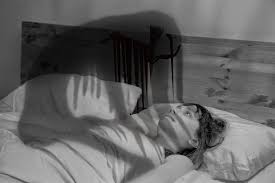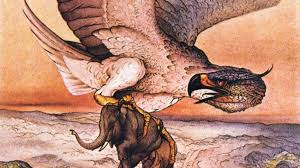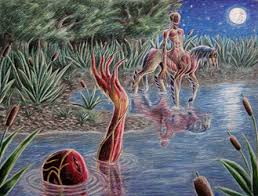Mythical Monsters: Sleep Paralysis Figures
“To die, to sleep – to sleep, perchance to dream – ay, there’s the rub, for in this sleep of death what dreams may come…” –Hamlet

The shadow child playing with a sleeper.
Late at night, when you’re the only one awake and have to creep downstairs for a glass of water or a midnight snack, do you ever feel like you’re being…watched? That there’s something behind you, waiting for you to turn around? That those shadows in the corner might have just moved, and whatever you do, you shouldn’t look in the mirror as you pass your bathroom? You call yourself stupid and childish, yet the moment you turn the lights off, you sprint to your room and take a running leap into your bed to avoid whatever might be lurking beneath it.
Well, I’ve got good news and bad news: as a matter of fact, you probably are being watched—but your audience is mostly harmless.
Perhaps you are familiar with sleep paralysis. It’s a terrifying phenomenon where a sleeper awakens paralyzed, often with a feeling of breath-choking terror and hallucinations of horrible figures often described as ‘demonic,’ ‘violent,’ or ‘hostile.’ If you’ve ever seen Renaissance paintings of shadowy figures or little hobgoblins crowding around a sleeping woman, you’ve seen an early depiction of sleep paralysis before it was understood to be a neurological phenomenon. Scientists still aren’t sure what causes it, but they have treatments that lessen the frequency of the paralytic episodes. However, many sleep paralysis episodes share a common thread that science can’t explain: several apparitions seem to be recurring, described in an almost identical fashion by victims worldwide.
The hag is a ghastly old woman whose modus operandi is to stand over the sleeper or sit on their chests, sometimes covering their mouth with her claw-like fingers. She is always accompanied by a crushing sensation, as though the sufferer is not only being choked but their whole chest is caving in. Next are the hat man and cloak man, possibly the same creature in a different guise. He is described as a human-like shadow wearing a Quaker hat or a cloak, either standing in the corner or pacing around the room. Some people report that he is a benign figure, appearing to warn of imminent danger; others report feeling waves of malevolence rolling off of him, especially if they glimpse his yellow, snake-like eyes from under his hat. Sometimes, the hat/cloak man appears with a shadow child, a formless, ‘smoky’ shadow that seems to collect or congeal in the corners of the room or at the foot of the bed. While nothing indicates childishness in its outward appearance, witnesses claim to feel a sense of child-like curiosity or shyness emanating from the shadow; rarely, they hear garbled speech with the cadence of a song or nursery rhyme. When in the presence of the shadow child, the hat man exudes an air of amused benevolence akin to a kindly uncle watching over a favorite niece or nephew; in the pair’s presence, people claim to feel safe and protected, allowing them to relax out of the paralytic state and return to sleep, not realizing until they awaken the next morning how strange the experience was. Rarely, the shadow child appears by itself, jumping onto the paralytic’s bed and tangling small hands into their hair—not intentionally trying to pull, but rather behaving like a small child clumsily trying to give their indulging older sibling a makeover.
Stranger than this triad’s repeated appearances are the tales of new parents being scared witless by their children speaking to entities they cannot see, particularly in the dead of night with no witness save the baby monitor. When asked about their supposed imaginary friend, children up to the age of five often describe a figure very near the hat man, as did a young boy from Missouri: “That man!” he when his father asked who he was talking to, cheerfully pointing at empty air. When asked what ‘the man’ looks like, the boy said, “A big, dark man with a big coat. He watches me when you’re away because he doesn’t want me to be lonely. He says I can play with his pets but I can’t ever, ever try to see his face. He says bad things will happen to you and mommy if I do.”
With so many similar accounts, it would be foolish to deny that victims of sleep paralysis are interacting with the same creatures over many episodes. This points to a bigger question: who are these figures, what do they want, and where did they come from? It has long been theorized that the hallucinations of schizophrenics may be their brains’ attempt to process what they are seeing in dimensions beyond our own; perhaps the hallucinations associated with sleep paralysis are brought on by extradimensional figures visiting in the dead of night.







